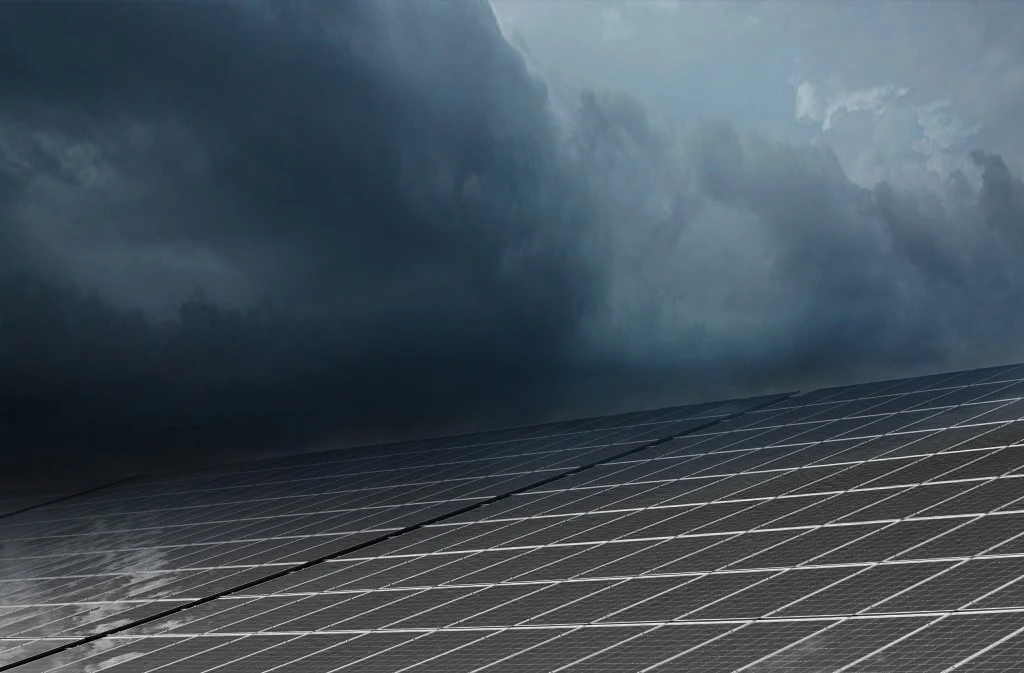- Updated On: March 13, 2025
Solar Panel Lifespan:
How Long Do They Last?
In the United States, homeowners and businesses are rapidly transitioning to solar power. Investing in solar is a great option to get rid of increasing energy bills for the future, protect against frequent power outages, and more grid independence. However, when considering solar installation, it is a common concern of many customers: how long do solar panels last? Understanding the solar panel lifespan is essential as it reflects the worth of your solar investment. Fortunately, due to solar technological developments, the longevity of panels has improved over time. In fact, modern panels now may last up to 30 years.
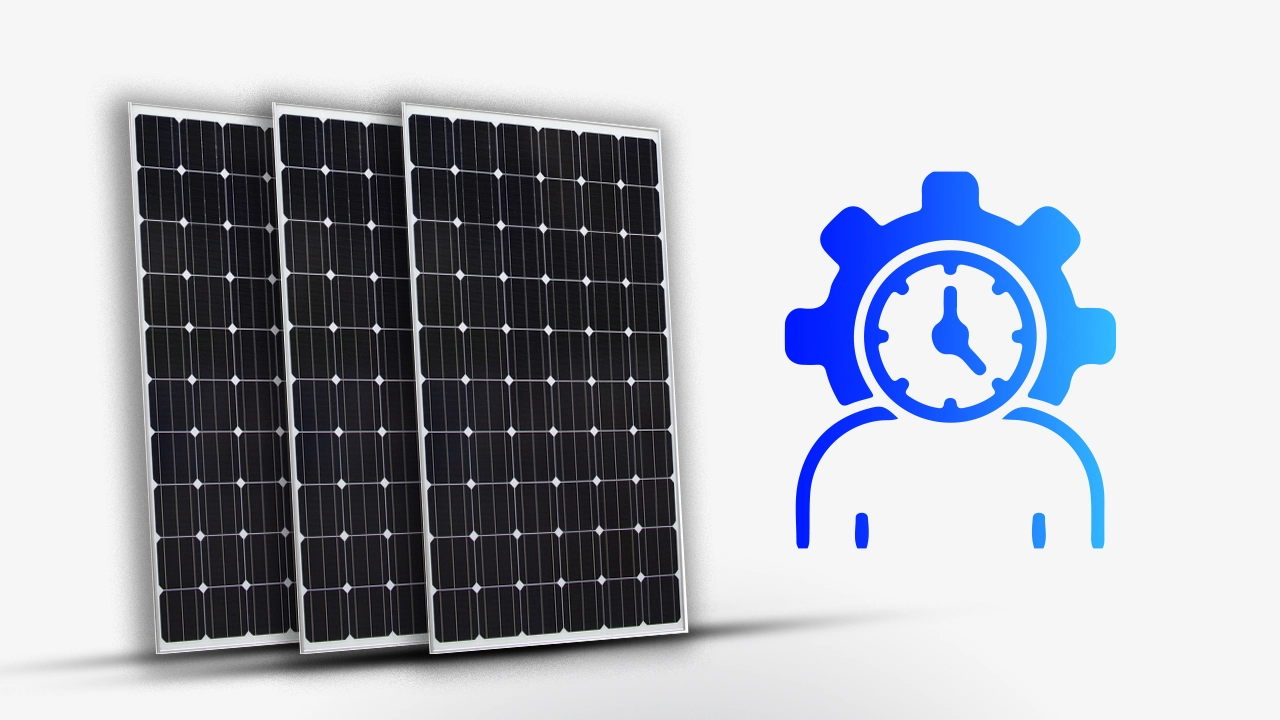
We will explain in this article how long solar panels last, solar degradation rates, and factors that affect solar efficiency. We will also assist you with ways to increase your solar panel lifespan.
What is the solar panel lifespan?
The question that bothers every solar system owner is if I switch to solar energy, how long do solar panels last. Solar panels are exceptionally durable. The lifespan of a solar panel is not measured by when it stops generating power. Instead, its useful life determines longevity which is 25-30 years on average. Solar panels slowly degrade and produce less electricity year after year.
However, a solar panel’s lifespan may vary depending on factors including the panel’s quality, its installation procedure, and its maintenance. With proper care, you may increase your home solar system’s useful time.
What is a solar panel degradation rate?
The “degradation rate” is when solar panels lose their capacity to capture sunlight and transform it into solar energy over time. Hot weather and the panels’ natural decline in chemical potency are two factors that cause this.
According to National Renewable Energy Laboratory (NREL) research, the production of solar panels decreases by 0.5% to 0.8% annually on average. Over time, a solar panel with a lower rate of degradation will generate more electricity. In simple terms, a solar panel is better if its rate of degradation is lower. It also varies by brand. High-quality panels will degrade more slowly than cheap ones. So, the degradation rate is an important factor when choosing a solar panel brand.
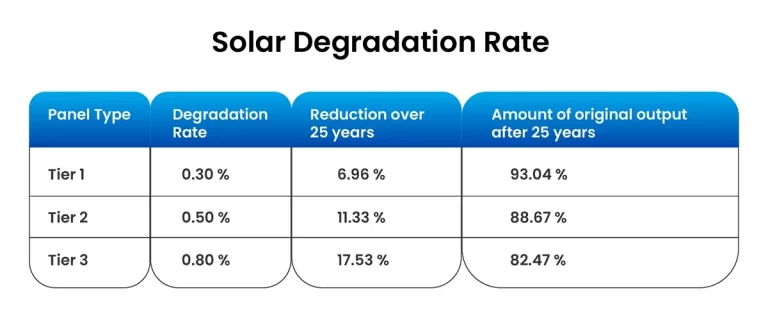
As solar panel technology advances, degradation rates are also improving. Premium solar manufacturers like Panasonic and LG are offering panels with annual deterioration rates as low as 0.30%.
What are the factors impacting the efficiency and longevity of solar panels?
Some factors may impact the performance, efficiency, and lifespan of your solar energy system. These are:
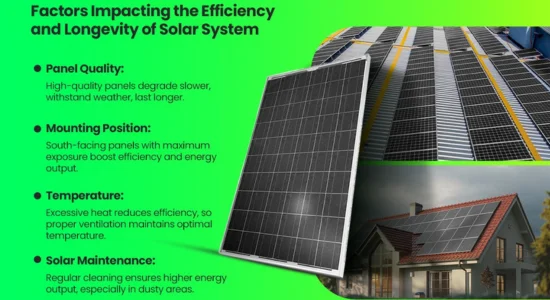
Panel Quality:
The quality of a solar panel is a considerable variable that may affect its lifespan. High-quality solar panels have less degradation over time and can withstand extreme weather. Cheap panels, on the other hand, may be damaged by hail or not last long.
Mounting Position:
The amount of solar energy that solar panels can absorb determines how they work. Solar mounting is an important consideration for energy generation. Your panels will operate more efficiently if you install them with the most solar exposure. For rooftop systems, the best orientation is south-facing in getting full day sun exposure.
Temperature:
One vital factor is the average temperature in your area. Excessive heat may decrease the solar panel and lower the energy output of your system. You can install your system to allow for adequate air circulation and maintain an optimal working temperature as per your location.
Solar Maintenance:
As an energy-efficient technology, solar panels need minimal maintenance. However, if you live in an area with dust, debris, or snow, routine cleaning may improve your long-term energy output.
How to maximize the solar panel lifespan?
In general, solar panels are quite durable. The majority of panels are designed and tested to withstand bad weather conditions, including hail damage, strong winds, and a lot of snow. Additionally, they often require little to no maintenance because they don’t have any moving parts. However, keeping your home energy system maintained can boost its longevity and energy output. Below are some tips to make the most out of your residential solar system:
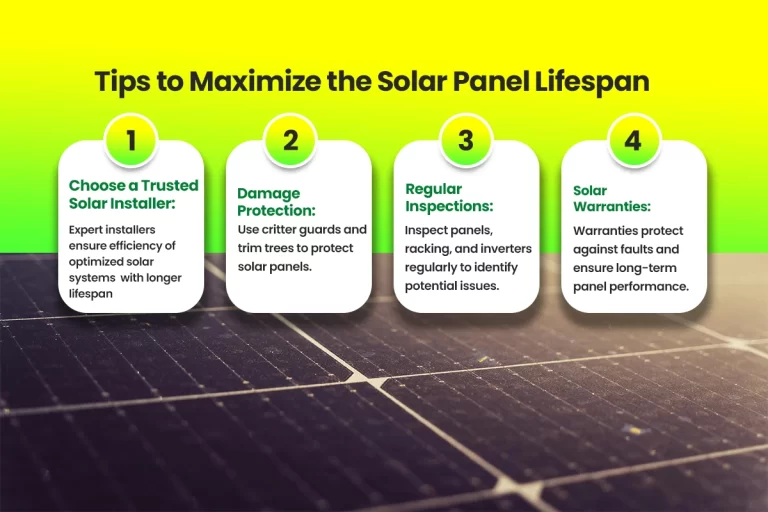
Choose a Trusted Solar Installer:
Choosing a trustworthy installer like Solar SME, who provides industry-leading warranties and good customer service, is the best way to ensure your solar panels will last for a long time. If your system is not installed properly, even the best solar panels will not perform with efficiency. The solar installation is the first step towards its longevity. With quality equipment, an expert installer will design a system tailored to your specific requirements. Also, to shorten your solar payback period, they assist you with solar rebates and incentives in your area.
Damage Protection:
As long as your solar panels are safe from physical damage, they will continue to generate energy for years. To protect your system, you can buy specialty products for panel safety. Like, solar panel critter guards can prevent animals like squirrels and birds from nesting under your panels, which can damage the system and wires over time. You may also need to cut or trim nearby trees to prevent branches from falling on your solar panels modules.
Regular Inspections:
Routine inspections help you to identify potential problems, including loose racking, exposed cables, PV system losses, etc. Also, along with your solar panels, you should check your racking system and the efficiency of your solar inverter. You may need to replace your inverter approximately halfway through the solar panel’s lifespan, depending on the type you install. Centralized string inverters have a lifespan of approximately 10 to 15 years, while microinverters often have the same lifespan as their solar panels.
Solar Warranties:
The key to expanding the solar lifespan is solar panel warranties. Your equipment warranty protects against manufacturing faults, and your performance (also known as power) warranty ensures that your solar panels will continue to produce a specific percentage of their initial output annually. This will help you to figure out how quickly your solar panels are expected to degrade.
When should you consider replacing solar panels?
After 25 years of solar panel lifespan, if you notice that your energy bills are again increasing, it may be because your system is underperforming. This will be a sign for you to replace your PV panels. Many solar companies provide solar monitoring apps to track electricity generation on a daily or monthly basis. Understanding how much power your panels typically produce will help you identify any exceptions.
The discussion concludes that investing in solar is worth it, as you can expect lower to no energy bills and less grid reliance for 25-30 years with very little maintenance. However, it is vital to choose the high-efficiency panels, the right system size, and the placement of panels, to maximize solar efficiency and boost solar panel lifespan.
Solar SME is a trusted solar installer near you. Book a FREE appointment to explore the best solar panel brands and tailored system designs according to your home needs.
Related Articles:
In the United States, rising inflation, high energy costs, extreme weather, frequent power outages, and less grid reliance are the major reasons for switching to solar.
Hurricanes are powerful natural disasters that can wreak havoc on buildings and destroy infrastructures causing economic and personal losses.
If you have ever wondered how solar panels work you are not alone. People around the world have studied solar energy for nearly 200 years.


